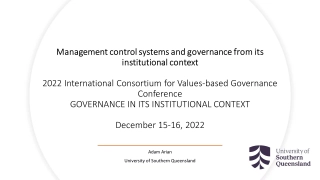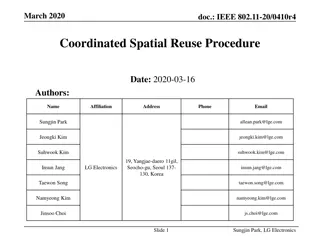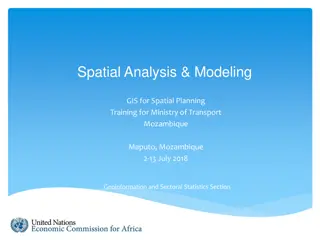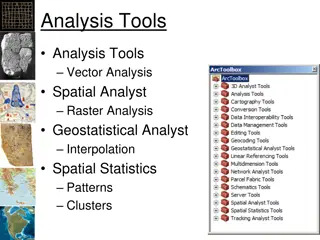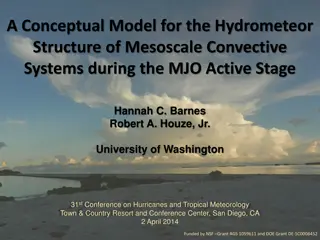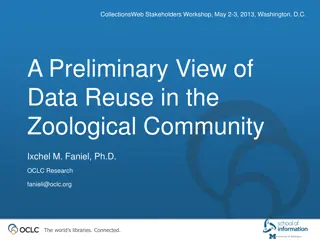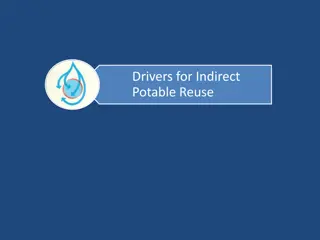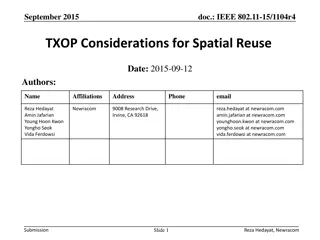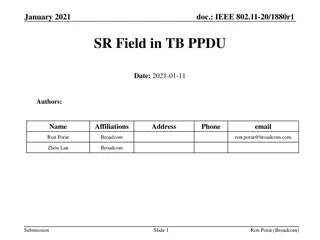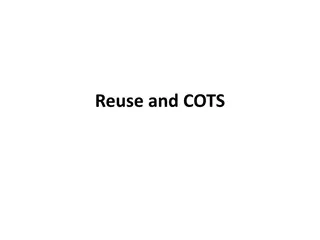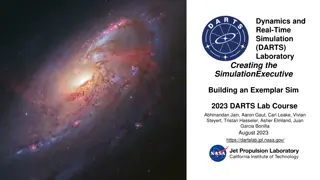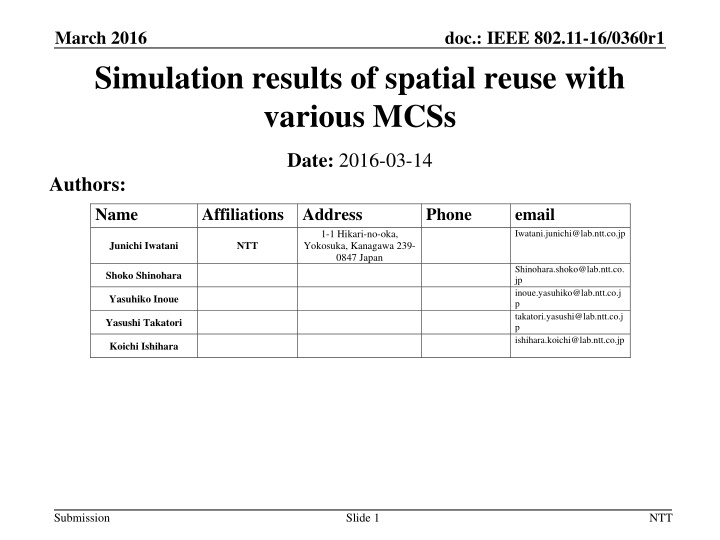
Simulation Results of Spatial Reuse in IEEE 802.11-16 Environment
Explore the impact of Dynamic Sensitivity Control (DSC) and Transmit Power Control (TPC) on spatial reuse in wireless networks. The study evaluates various Modulation and Coding Schemes (MCSs) to optimize performance and reduce interference, crucial for maximizing throughput. Dive into the details of receiver behavior, DSC modes, TPC considerations, and simulation scenarios to enhance spatial reuse efficiency and minimize interference in IEEE 802.11-16 networks.
Download Presentation

Please find below an Image/Link to download the presentation.
The content on the website is provided AS IS for your information and personal use only. It may not be sold, licensed, or shared on other websites without obtaining consent from the author. If you encounter any issues during the download, it is possible that the publisher has removed the file from their server.
You are allowed to download the files provided on this website for personal or commercial use, subject to the condition that they are used lawfully. All files are the property of their respective owners.
The content on the website is provided AS IS for your information and personal use only. It may not be sold, licensed, or shared on other websites without obtaining consent from the author.
E N D
Presentation Transcript
March 2016 Simulation results of spatial reuse with various MCSs doc.: IEEE 802.11-16/0360r1 Date: 2016-03-14 Authors: Name Affiliations Address Phone email Iwatani.junichi@lab.ntt.co.jp 1-1 Hikari-no-oka, Yokosuka, Kanagawa 239- 0847 Japan Junichi Iwatani NTT Shinohara.shoko@lab.ntt.co. jp inoue.yasuhiko@lab.ntt.co.j p takatori.yasushi@lab.ntt.co.j p ishihara.koichi@lab.ntt.co.jp Shoko Shinohara Yasuhiko Inoue Yasushi Takatori Koichi Ishihara Submission Slide 1 NTT
March 2016 doc.: IEEE 802.11-16/0360r1 Abstract Several contributions have been presented to evaluate the effect of DSC and TPC with simulation results [1], [2]. Spatial reuse with DSC can improve mean throughput. On the other hand, spatial reuse may increase interference, especially when STAs are not located near an AP, and the effect of increased interference has not been evaluated in detail. To maximize the advantage of spatial reuse and reduce the effect of interference, the following controls seem to be necessary: ON/OFF of DSC Threshold adjustment and TPC MCS optimization In this contribution, we present simulation results with several MCS parameters and evaluate how the MCS selection affect the performance. Submission Slide 2 NTT
March 2016 doc.: IEEE 802.11-16/0360r1 DSC and receiver behavior In this document, regarding DSC, only OBSS_PD level is controlled. We assume the following receiver behavior: During carrier sensing, an STA detects signals with >= -76dBm in a 80MHz channel bandwidth. Detection of the legacy preamble: If the legacy preamble is detected properly, the frame is regarded as a wireless LAN frame. Otherwise, the frame is regarded as a non wireless LAN frame, and the channel status is checked with CCA-ED threshold (-56dBm with 80MHz). If both the legacy and the HE preambles are detected properly, the BSS color of the received frame is checked. If it is the same as the BSS color of the STA s BSS, the detection process continues. Otherwise, the detection is terminated, and the channel status is checked with OBSS_PD level (between -56dBm and -76dBm, variable). Submission Slide 3 NTT
March 2016 doc.: IEEE 802.11-16/0360r1 TPC There are some discussions about the use of power control in the context of spatial reuse [1], [4], [5]. In this document, two DSC modes are considered in terms of TPC as follows (considering that detailed TPC procedures are TBD): DSC w/o TPC: No TPC regardless of DSC. DSC w/ TPC: An AP with DSC uses TPC every time. Tx power of TPC is calculated as follows: ?[dB] = ????_??[dBm] ??_???????????[dBm] ??_???????????[dBm] = ??_?????[dBm] ?[dB] Submission Slide 4 NTT
March 2016 doc.: IEEE 802.11-16/0360r1 Simulation scenario Residential Scenario is used: 3 frequency reuse. AP is located at the center of each room. Two STAs are located in a room randomly. 5dB penetration loss for a wall between two adjacent BSSs. This enables DSC effective and the throughput can be improved. We evaluate the performance with BSS F since there are may OBSSs around it. A B D E G H I J C F K L M O P R S T Q N Min SINR in BSS_F is 10dB (two walls) (with interference from AP Q) d=30m and 3walls, RSSI = -78.60dBm F C d=14m, 2walls RSSI = -62.17dBm d=22m, 3walls RSSI = -74.13dBm Q N Submission Slide 5 NTT
March 2016 doc.: IEEE 802.11-16/0360r1 Simulation parameters (1/2) PHY parameters BW All BSSs at 5GHz [80 MHz, no dynamic bandwidth] Channel model TGac D NLOS per link (no shadow fading) Data Preamble Type [5GHz, 11ac], duration is considered. STA TX Power 15 dBm per antenna AP TX Power 20 dBm per antenna AP number of TX/RX antennas 1/1 STA number of TX/RX antennas 1/1 AP antenna gain 0 dBi STA antenna gain -2 dBi Noise Figure 7dB CCA-SD threshold -76dBm/80MHz CCA-ED (for any signal) threshold -56dBm/80MHz Rx sensitivity -76dBm/80MHz (a packet with lower rx power is dropped) OBSS-PD threshold -73/-68/-62 dBm Link Adaption Fixed MCS =3 or 5 or 7 PHY abstraction RBIR, BCC Channel correlation Same as defined in the used channel model Capture Window 800 nsec 9.0 dB (if a new PPDU arrives with rx power above 9.0dB the current reception, then capture phase is re-entered with this new PPDU) Preemption Level Submission Slide 6 NTT
March 2016 doc.: IEEE 802.11-16/0360r1 Simulation parameters (2/2) MAC parameters Access protocol [EDCA, AC_BE with default parameters] [CWmin = 15, CWmax = 1023, AIFSn=3 ] Queue length A single queue for each traffic link is set inside AP/STA sized of 2000 packets Traffic type UDP 200Mbit/s per a STA MPDU size 1540 Bytes (1472 Data + 28 IP header + 40 MAC header) [A-MPDU / max aggregation size / BA window size, No A-MSDU, with immediate Aggregation BA], Max aggregation: 32 MPDUs with 4-byte MPDU delimiter Max number of retries 10 Beacon Disabled RTS/CTS OFF DL only Traffic direction Throughput metric Histogram of per non-AP STA throughput (received bits/overall simulation time) Submission Slide 7 NTT
March 2016 doc.: IEEE 802.11-16/0360r1 Simulation results (MCS 5 only) Throughput is evaluated with DSC and without DSC (legacy only), MCS5 only. 100 legacy only DSC w/o TPC (p=-73dBm) DSC w/o TPC (p=-68dBm) DSC w/o TPC (p=-62dBm) DSC w/ TPC (p=-73dBm) DSC w/ TPC (p=-68dBm) DSC w/ TPC (p=-62dBm) OBSS_PD threshold (=p): -73dBm, -68dBm, -62dBm 80 TPC: ON/OFF The throughput with DSC is higher than that of legacy as a whole. 60 CDF The conditions with DSC (w/TPC, OBSS_PD level = -62dBm, -68dBm) show the highest mean throughput. 40 However, around CDF 5%, the throughput of these conditions is low. 20 - As shown in Slide 5, if the location of the STA is not near the AP, the SINR is worse and the throughput decreases. 0 0 20 40 60 80 100 To avoid the degradation, we need further control considering the interference level. Per STA throughput (Mbit/s) Submission Slide 8 NTT
March 2016 doc.: IEEE 802.11-16/0360r1 Simulation results (MCS3, 5, 7) legacy only DSC w/ TPC (p=-68dBm) legacy only DSC w/ TPC (p=-68dBm) legacy only DSC w/ TPC (p=-68dBm) MCS3 MCS5 MCS7 The simulation results with MCS 3,5 and 7 (legacy and with DSC w/TPC, OBSS_PD_level = -68dBm) are the following: 100 Over 20%tile: The throughput is the highest on the condition of DSC w/TPC, MCS7 . 80 60 Between 15%tile and 20%tile: The throughput is the highest on the condition of DSC w/TPC, MCS5 . CDF 40 Below 15%tile: The throughput is the highest on the conditions of legacy only, MCS7 or DSC w/TPC, MCS3 . 20 - The throughput decreases on the condition of DSC w/ TPC, MCS7 compared with the case of legacy. 0 0 20 40 60 80 100 120 Per STA throughput (Mbit/s) Submission Slide 9 NTT
March 2016 doc.: IEEE 802.11-16/0360r1 Statistic values Average Gain (to "legacy only") 5%tile Gain (to "legacy only") 50%tile Gain (to "legacy only") Value (Mbit/s) Value (Mbit/s) Value (Mbit/s) legacy only 29.93 1.00 26.37 1.00 27.89 1.00 DSC w/o TPC (p=-73dBm) 36.75 1.23 27.38 1.04 34.49 1.24 DSC w/o TPC (p=-68dBm) 36.28 1.21 26.88 1.02 33.04 1.18 MCS3 DSC w/o TPC (p=-62dBm) 43.78 1.46 28.64 1.09 45.22 1.62 DSC w/ TPC (p=-73dBm) 35.77 1.20 26.93 1.02 29.52 1.06 DSC w/ TPC (p=-68dBm) 52.11 1.74 51.90 1.97 52.13 1.87 DSC w/ TPC (p=-62dBm) 52.01 1.74 51.50 1.95 52.12 1.87 legacy only 54.27 1.00 45.22 1.00 53.29 1.00 DSC w/o TPC (p=-73dBm) 62.62 1.15 46.92 1.04 58.91 1.11 DSC w/o TPC (p=-68dBm) 62.18 1.15 47.79 1.06 58.61 1.10 MCS5 DSC w/o TPC (p=-62dBm) 77.81 1.43 41.76 0.92 83.15 1.56 DSC w/ TPC (p=-73dBm) 65.61 1.21 46.92 1.04 61.06 1.15 DSC w/ TPC (p=-68dBm) 85.65 1.58 11.87 0.26 97.62 1.83 DSC w/ TPC (p=-62dBm) 90.18 1.66 9.79 0.22 97.61 1.83 legacy only 65.08 1.00 53.82 1.00 64.00 1.00 DSC w/o TPC (p=-73dBm) 71.68 1.10 54.28 1.01 68.83 1.08 DSC w/o TPC (p=-68dBm) 70.76 1.09 55.69 1.03 68.08 1.06 MCS7 DSC w/o TPC (p=-62dBm) 85.87 1.32 41.45 0.77 92.25 1.44 DSC w/ TPC (p=-73dBm) 74.97 1.15 55.11 1.02 66.90 1.05 DSC w/ TPC (p=-68dBm) 98.78 1.52 14.32 0.27 117.90 1.84 DSC w/ TPC (p=-62dBm) 97.36 1.50 11.44 0.21 118.11 1.85 Submission Slide 10 NTT
March 2016 doc.: IEEE 802.11-16/0360r1 Effect of MCS selection and DSC In the residential scenario, SINR may be worse due to interference when adjacent APs transmit frames at the same time, and the throughput may decrease by half if a STA is located far from the AP. To achieve higher throughput by using DSC, transmitted frames should be received successfully with a high probability. In order to improve the throughput regardless of the location of STAs, one of the possible ways is use of MCS control in conjunction with DSC, i.e., optimization of the OBSS_PD threshold. Submission Slide 11 NTT
March 2016 doc.: IEEE 802.11-16/0360r1 Conclusion We evaluated the throughput with the residential scenario to show the effect of spatial reuse with several MCS parameters. DSC improves the mean and average throughput. However, in the worst small percentile cases, the throughput decreases since the STAs are located randomly. In order to achieve higher throughput, one of the possible ways is use of MCS control in conjunction with DSC, i.e., optimization of the OBSS_PD threshold. Submission Slide 12 NTT
doc.: IEEE 802.11-16/0360r1 References [1] Takeshi Itagaki, Dynamic CCA control and TPC Simulation Results with SS1~SS3, doc.: IEEE 802.11-15/1045r0 [2] Jinmin Kim, Simulation results for spatial reuse in 11ax, doc.: IEEE 802.11-15/1284r0 [3] Ron Porat, 11ax Evaluation Methodology, doc.:IEEE 802.11- 14/0571r12 [4] James Wang, Adaptive CCA and TPC, doc.:IEEE 802.11- 15/1069r3 [5] V. Mhatre, K. Papagiannaki, and F. Bacceli, Interference mitigation through power control in high density 802.11 WLANs in Proc. IEEE INFOCOM 2007, Anchorage, USA, May 2007. Submission 13

